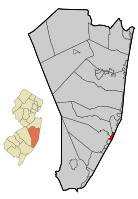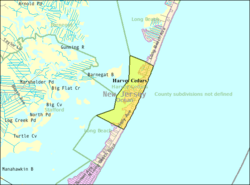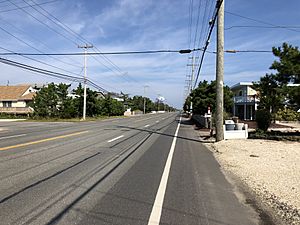Harvey Cedars, New Jersey facts for kids
Quick facts for kids
Harvey Cedars, New Jersey
|
|
|---|---|
|
Borough
|
|
| Borough of Harvey Cedars | |

Map of Harvey Cedars in Ocean County. Inset: Location of Ocean County highlighted in the State of New Jersey.
|
|

Census Bureau map of Harvey Cedars, New Jersey
|
|
| Country | |
| State | |
| County | |
| Incorporated | November 20, 1894 |
| Government | |
| • Type | Walsh Act |
| • Body | Board of Commissioners |
| Area | |
| • Total | 1.19 sq mi (3.08 km2) |
| • Land | 0.56 sq mi (1.45 km2) |
| • Water | 0.63 sq mi (1.62 km2) 52.61% |
| Area rank | 488th of 565 in state 23rd of 33 in county |
| Elevation | 3 ft (0.9 m) |
| Population | |
| • Total | 337 |
| • Estimate
(2019)
|
345 |
| • Rank | 559th of 566 in state 32nd of 33 in county |
| • Density | 604.6/sq mi (233.4/km2) |
| • Density rank | 427th of 566 in state 24th of 33 in county |
| Time zone | UTC−05:00 (Eastern (EST)) |
| • Summer (DST) | UTC−04:00 (Eastern (EDT)) |
| ZIP Code |
08008
|
| Area code(s) | 609 exchanges: 207, 361, 492, 494 |
| FIPS code | 3402930390 |
| GNIS feature ID | 0885246 |
Harvey Cedars is a borough in Ocean County, New Jersey, United States. As of the 2010 United States Census, the borough's population was 337, reflecting a decline of 22 (-6.1%) from the 359 counted in the 2000 Census, which had in turn declined by 3 (-0.8%) from the 362 counted in the 1990 Census. The borough borders the Atlantic Ocean on Long Beach Island.
Harvey Cedars was incorporated as a borough by an act of the New Jersey Legislature on December 15, 1894, from portions of Union Township (now Barnegat Township), based on the results of a referendum held on November 20, 1894. The community's post office was initially known as High Point, the name of a neighborhood in the borough that lies at a higher elevation, before a name change was made in the 1930s at the request of the United States Postal Service to differentiate the post office from the northern New Jersey community of High Point in Sussex County.
The majority of the housing units in the borough are seasonal houses used primarily in the summer by owners who live elsewhere, bringing the summer population to 12,000. The borough's quiet character and bay and ocean access make housing very expensive, with many bay or oceanfront houses priced at $2 million or more. Despite the borough's small size, its property was assessed at over $1.28 billion in 2019.
Contents
History
Before Long Beach Island was developed, its northern area, from the Barnegat Inlet to the Great Swamp (now Surf City), was covered with Atlantic white cedar (chamaecyparis thyoides). Early inhabitants of the area harvested salt hay (spartina patens) and seaweed to make a living.
The earliest reference to the area was a deed from 1751 that called the place "Harvest Quarters". The name "Harvey Cedars" may be a portmanteau derived from the combination of "harvest" housing used by these farmers and the "cedars" that grew in the area.
Geography
According to the United States Census Bureau, the borough had a total area of 1.185 square miles (3.070 km2), including 0.557 square miles (1.444 km2) of land and 0.628 square miles (1.626 km2) of water (52.97%).
Unincorporated communities, localities and place names located partially or completely within the borough include High Point.
The borough borders the Ocean County municipalities of Barnegat Township, Long Beach Township and Stafford Township.
Demographics
| Historical population | |||
|---|---|---|---|
| Census | Pop. | %± | |
| 1900 | 39 | — | |
| 1910 | 33 | −15.4% | |
| 1920 | 65 | 97.0% | |
| 1930 | 53 | −18.5% | |
| 1940 | 74 | 39.6% | |
| 1950 | 106 | 43.2% | |
| 1960 | 134 | 26.4% | |
| 1970 | 314 | 134.3% | |
| 1980 | 363 | 15.6% | |
| 1990 | 362 | −0.3% | |
| 2000 | 359 | −0.8% | |
| 2010 | 337 | −6.1% | |
| 2019 (est.) | 345 | 2.4% | |
| Population sources: 1900–2000 1900–1920 1900–1910 1910–1930 1930–1990 2000 2010 |
|||
Census 2010
As of the census of 2010, there were 337 people, 169 households, and 110 families residing in the borough. The population density was 604.6 per square mile (233.4/km2). There were 1,214 housing units at an average density of 2,178.0 per square mile (840.9/km2)*. The racial makeup of the borough was 99.11% (334) White, 0.59% (2) Black or African American, 0.00% (0) Native American, 0.30% (1) Asian, 0.00% (0) Pacific Islander, 0.00% (0) from other races, and 0.00% (0) from two or more races. [[Hispanic (U.S. Census)|Hispanic or Latino of any race were 0.89% (3) of the population.
There were 169 households out of which 13.6% had children under the age of 18 living with them, 59.8% were married couples living together, 5.3% had a female householder with no husband present, and 34.9% were non-families. 32.0% of all households were made up of individuals, and 18.3% had someone living alone who was 65 years of age or older. The average household size was 1.99 and the average family size was 2.47.
In the borough, the population was spread out with 11.6% under the age of 18, 4.5% from 18 to 24, 10.1% from 25 to 44, 32.0% from 45 to 64, and 41.8% who were 65 years of age or older. The median age was 61.6 years. For every 100 females there were 97.1 males. For every 100 females ages 18 and old there were 97.4 males.
The Census Bureau's 2006–2010 American Community Survey showed that (in 2010 inflation-adjusted dollars) median household income was $106,875 (with a margin of error of +/- $15,693) and the median family income was $112,656 (+/- $8,889). Males had a median income of $85,625 (+/- $32,732) versus $51,875 (+/- $42,840) for females. The per capita income for the borough was $74,525 (+/- $13,683). About 3.0% of families and 4.2% of the population were below the poverty line, including none of those under age 18 and 6.2% of those age 65 or over.
Census 2000
As of the 2000 United States Census there were 359 people, 167 households, and 112 families residing in the borough. The population density was 657.1 people per square mile (252.0/km2). There were 1,205 housing units at an average density of 2,205.6 per square mile (845.9/km2). The racial makeup of the borough was 96.94% White, 0.56% African American, 0.28% Native American, 0.28% Asian, 1.95% from other races. Hispanic or Latino of any race were 3.62% of the population.
There were 167 households, out of which 16.8% had children under the age of 18 living with them, 61.7% were married couples living together, 4.2% had a female householder with no husband present, and 32.9% were non-families. 29.3% of all households were made up of individuals, and 15.6% had someone living alone who was 65 years of age or older. The average household size was 2.15 and the average family size was 2.61.
In the borough the population was spread out, with 14.5% under the age of 18, 4.2% from 18 to 24, 22.0% from 25 to 44, 29.0% from 45 to 64, and 30.4% who were 65 years of age or older. The median age was 54 years. For every 100 females, there were 102.8 males. For every 100 females age 18 and over, there were 106.0 males.
The median income for a household in the borough was $61,875, and the median income for a family was $69,722. Males had a median income of $71,042 versus $32,361 for females. The per capita income for the borough was $36,757. About 2.6% of families and 5.1% of the population were below the poverty line, including 5.1% of those under age 18 and 2.9% of those age 65 or over.
Transportation
Roads and highways
As of May 2010[update], the borough had a total of 9.82 miles (15.80 km) of roadways, of which 7.59 miles (12.21 km) were maintained by the municipality and 2.23 miles (3.59 km) by Ocean County.
No Interstate, U.S. or state highways serve Harvey Cedars. The main road serving the borough is County Route 607 (Long Beach Boulevard).
Public transportation
Ocean County Ride provides bus service on the OC9 LBI North route between Barnegat Light and Manahawkin / Stafford Township.
The LBI Shuttle operates along Long Beach Boulevard, providing free service every 5 to 20 minutes from 10:00 AM to 10:00 PM. It serves the Long Beach Island municipalities / communities of Barnegat Light, Loveladies, Harvey Cedars, North Beach, Surf City, Ship Bottom, Long Beach Township, Beach Haven and Holgate.
Education
For kindergarten through sixth grade, public school students attend the Long Beach Island Consolidated School District, which also serves students from Barnegat Light, Long Beach Township, Ship Bottom and Surf City. As of the 2017–18 school year, the district, comprised of two schools, had an enrollment of 234 students and 33.1 classroom teachers (on an FTE basis), for a student–teacher ratio of 7.1:1. Schools in the district (with 2017-18 enrollment data from the National Center for Education Statistics) are Ethel Jacobsen School in Surf City with 111 students in pre-kindergarten to second grade and Long Beach Island Grade School in Ship Bottom with 125 students in grades 3 – 6. The district's board of education is made of nine members who are directly elected from the constituent municipalities on a staggered basis, with three members elected each year. Of the nine seats, one member is elected from Harvey Cedars.
Students in public school for seventh through twelfth grades attend the Southern Regional School District, which serves the five municipalities in the Long Beach Island Consolidated School District, along with students from Beach Haven and Stafford Township, as well as students from Ocean Township (including its Waretown section) who attend as part of a sending/receiving relationship. Schools in the district (with 2017-18 enrollment data from the National Center for Education Statistics) are Southern Regional Middle School with 944 students in grades 7–8 and Southern Regional High School with 1,941 students in grades 9–12. Both schools are in the Manahawkin section of Stafford Township.
At the time of its founding in 1957, the Southern Regional School District had a roughly equal number of students from Long Beach Island and Stafford Township. By 2016, the overwhelming majority of students were from Stafford Township, accounting for nearly 90% of enrollment. These demographic changes have led to significant discrepancies in the cost per pupil sent to the district from each community, with Harvey Cedars and Long Beach Township paying more than $200,000 per pupil, while Stafford Township's costs are $3,600 for each student. These widely different costs result from a formula that uses the taxable property value in each municipality to apportion costs, which means that municipalities with relatively high property values and small numbers of students pay a higher share of total district costs. Some residents of Long Beach Island communities are seeking to amend the formula to take advantage of a 1993 law that allows districts to use both property value and enrollment to allocate property taxes, though that would require passage of referendums in each municipality.
Noted residents
People who were born in, residents of, or otherwise closely associated with Harvey Cedars include:
- Wendy Mae Chambers (born 1953), composer.
- Paul L. Gill (1894–1938), watercolor painter and teacher.
- Sue May Gill (1887–1989), artist and member of the Philadelphia Ten.
- Leon Kelly (1901–1982), artist best known for his contributions to Surrealism.
- Nathan Gregory Silvermaster (1898–1964), economist with the United States War Production Board during World War II, who was the head of a large Communist spy ring in the U.S. government.
See also
 In Spanish: Harvey Cedars para niños
In Spanish: Harvey Cedars para niños


